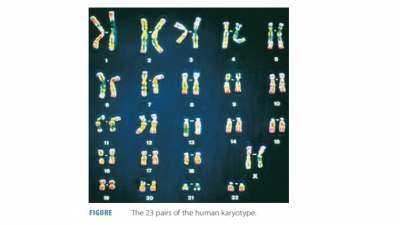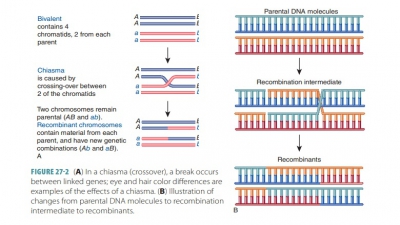Heredity: Gender-Related Factors
| Home | | Anatomy and Physiology | | Anatomy and Physiology Health Education (APHE) |Chapter: Anatomy and Physiology for Health Professionals: Heredity
Gender-Related Factors - Sex Determination: Genes on Sex Chromosomes, Gender Effects on Phenotype; Chromosome Disorders: Polyploidy, Aneuploidy
Gender-Related
Factors
The human somatic or nonsex cells are the X and Y
chromosomes of males and the two X chromosomes of females. Each egg carries one
X chromosome, while sperm carry either an X or a Y chromosome. At con-ception,
sex is determined. When a Y-bearing sperm fertilizes an egg, a male is
conceived, and when an X-bearing sperm fertilizes an egg, a female is
con-ceived. A male is termed the heterogametic
sex since the two chromosomes are different and a female is termed the homogametic sex since the two
chromo-somes are the same.
Sex Determination
Development of male characteristics is derived from a Y
chromosome gene called SRY for the
sex- determining region of the Y chromosome. The SRY gene encodes a protein
called transcription factor, which
then activates other genes. SRY activates gene transcription, directing
development of male struc-tures in an embryo. It also suppresses formation of
female structures. Absence of the SRY transcription factor along with
expression of the gene called Wnt4
causes development of a female body to occur.
Genes on Sex Chromosomes
Genes that are part of X and Y chromosomes are inherited
differently than autosomal genes. This is due to the different sex chromosome
makeups of males and females. X-linked traits are transmitted on the X
chromosome, which has more than 1,500 genes, and Y-linked traits are
transmitted on the Y chromosome, which has only 231 protein-encoding genes.
There are three groups of Y-linked genes, based on
similarities to X-linked genes:
■■ One group is made up of genes at
the tips of the Y chromosome that have counterparts on the X chromosome. Many
proteins that function in both sexes are encoded by these genes, related to
bone growth, energy metabolism, and synthesis of receptors and hormones.
■■ Components of the second functional
group of Y chromosome genes are similar, in their DNA sequence, to certain X
chromosome genes. However, they are not exactly the same. The genes are
expressed in almost all tissues, including those that only exist in males.
■■ The third gene group includes those
unique to the Y chromosome. Many of these control male fertility, including the
SRY gene. Certain types of male infertility may develop due to deletions of
these parts of the Y chromosome. In this group, other genes encode proteins
participating in cell-cycle control. There are also proteins that regulate gene
expression, various enzymes, and protein receptors for biochemicals linked to
immunity.
Y-linked genes are only transmitted from fathers to their
sons, since only males have Y chromosomes. There are differences in inheritance
patterns of X-linked genes between females and males. This is linked to the
fact that any gene on a male’s X chromo-some is expressed in his phenotype,
since there is no second allele on a second X chromosome that masks its
expression. Males are hemizygous for
X-linked traits since there is only one copy of each X chromo-some gene. An
example of recessive X-linked traits is red-green
color blindness.
Each male inherits the Y chromosome from his father and the
X chromosome from his mother. Each female inherits one X chromosome from each
parent. When a mother is heterozygous for a certain X-linked gene, her son has
a 50% chance of inheriting either allele from her. Therefore, X-linked genes
are passed from mothers to their sons. X-inked recessive inher-itance is
exemplified in the transmission pattern of hemophilia A, a clotting disorder
passed from carrier mothers to affected sons at a risk of 50%. The affected son
can inherit either the mother’s normal allele or the mutant allele. A daughter
has a 50% chance of inher-ited the hemophilia allele, and then becoming a
car-rier (like her mother), as well as a 50% chance of not inheriting the
allele.
If a father is affected and a mother is a carrier, their
daughter could inherit an X-linked recessive dis-order. She would inherit one
affected X chromosome from each parent. Unless having a biochemical test, the
mother would not know she is a carrier of the X-linked recessive trait unless
she had an affected son. When X-linked recessive traits seriously affect
health, the affected male may not be well enough to father children. X-linked
recessive conditions that are almost as common in females as males usually have
mild phe-notypes. The mild X-linked trait of color blindness is an example. Men
with this condition are just as likely to father children as men with normal
color vision.
Dominant disease-causing alleles on the X chro-mosome are
rare. Males are usually affected more severely, since females have a second X
chromosome to offer some protection. The condition called incon-tinentia pigmenti causes females to have pigmented swirls of skin melanin, and may also
have thin hair, abnormal teeth, visual problems, and seizures. How-ever, males
with this condition have such severe effects that they usually die during
gestation.
Gender Effects on Phenotype
Because of differences between genders, some auto-somal
traits are expressed differently in males and females. A sex-limited trait affects a function or struc-ture that is present
only in males or only in females. It involves genes that are X-linked or
autosomal. Exam-ples of sex-limited traits include breast size and beard
growth. Females do not grow beards because they do not manufacture enough
hormones needed for facial hair growth. However, a mother can pass genes to her
sons that specify heavy beard growth.
In sex-linked
inheritance, an allele will be dom-inant in one sex but recessive in the
other sex. This, too, involves genes that are X-linked or autosomal. The
difference in expression shows hormonal dif-ferences between males and females.
An example is the gene for hair growth pattern, which has two alleles. One allele
produces hair all over the head and another allele causes pattern baldness. The
baldness allele is dominant in males, yet recessive in females. This is why
more males lose their hair than women.
A heterozygous male is bald, but a heterozygous female is
not. For a women to go bald, she must have two mutant alleles.
In genomic imprinting,
the expression of a disor-der is different, based on which parent transmits the
gene or chromosome that causes the disorder. Only about 1% of human genes
exhibit genomic imprint-ing. There may be differences in the severity of a
phe-notype, the age at which it begins, and even in the types of symptoms.
Genomic imprinting is physically based on methyl groups covering the gene from
one of the parents and blocking it from being transcribed and translated.
Chromosome Disorders
An excess or deficit of genes is linked to deviations from
the normal amount of 46 human chromosomes. Symptoms may also be linked to
chromosome rear-rangement. There may be an inversion of one section of a
chromosome or parts of two nonhomologous chromosomes may be exchanged.
Rearrangement can disrupt vital genes or cause unbalanced gametes with too much or insufficient genetic material.
When there are abnormal amounts of chromosomes, this can involve single
chromosomes or entire sets.
Polyploidy
Polyploidy
is
when there is an entire extra set of chro-mosomes. It is the most serious type
of chromosome disorder. It occurs from formation of a diploid gamete instead of
a normal haploid gamete. When a haploid sperm fertilizes a diploid egg, the
fertilized egg will be triploid,
meaning it will have three copies of each chromosome. Usually, a polyploid
embryo or fetus will stop development before being born. However, a poly-ploidy
infant may survive for a few days after birth, having severe abnormalities.
Various human organs have a few polyploid cells, but usually there is no
seri-ous health effects. An example is the liver cells, which can have four or
even eight sets of chromosomes.
Aneuploidy
Normal numbers of chromosomes are referred to as euploid. Cells that are missing a
chromosome or have an extra
chromosome are called aneuploidy. It
results from an error in meiosis known as nondisjunction.
Normally, pairs of homologous chromosomes separate during meiosis. Each
resulting gamete has only one member of each pair. In nondisjunction, one
chro-mosome pair does not separate, either in the first or second meiotic
division. A sperm or egg with two cop-ies of a certain chromosome or no copies
is produced instead of the normal one copy. When the gamete fuses with its
mate during fertilization, the zygote will have either 47 or 45 chromosomes
instead of 46.
Aneuploidy causes different symptoms based on the missing or
extra chromosome. Autosomal aneu-ploidy often causes intellectual
insufficiency, since many genes affect brain function. Sex chromosome
aneuploidy is not as severe. Additional genetic material is less problematic
than missing genetic material. Most children born with the wrong number of
chromosomes have an extra one, which constitutes trisomy. When there is a missing chromosome, it is called monosomy.
Traditionally, aneuploidy conditions were named for the
individuals who identified them. Today, they are designated by their affected
chromosome. For example, Down syndrome is also referred to as trisomy 21, since a distinct set of its symptoms are linked to this chromosome. It is the most common
autoso-mal aneuploidy. It can also develop when one copy of chromosome 21
exchanges parts with a different chromosome in a gamete and the fertilized ovum
receives too much chromosome 21 material. This chromosomal abnormality is
called a translocation. It is
important to identify if the affected person has trisomy 21 or translocation
Down syndrome, since the likelihood of trisomy 21 recurring in a sibling is
only about one in 100, but translocation Down syndrome recurs in much greater
numbers.
The next most common autosomal aneuploids are trisomies 13
and 18. They usually result in miscarriage of a fetus. An infant who has
trisomy 13 will have an underdeveloped face, additional fingers and toes that
are fused, small adrenal glands, heart defects, and a cleft lip or cleft
palate. Trisomy 18 causes similar prob-lems as well as abnormal positioning of
the fingers plus extra abdominal skin flaps. Trisomies of other autosomes do
not develop beyond embryosis.
Sex chromosome aneuploids are less severe. XO syndrome is
also called Turner syndrome, and
affects only one in 2,000 newborn females, representing just 1% of XO
conceptions. Delayed sexual development is often the only symptom. Though
infertility is usu-ally present, hormone supplements help affected indi-viduals
to live fairly normal lives. Nearly one of every 1,000–2,000 females has an
extra X chromosome in their body cells. This condition is called triplo-X and usually causes menstrual
irregularities and excessively tall height. When a male has an extra X
chromosome, he may also have Klinefelter or XXY syndrome. Similar to Xo
females, many XXY males usually do not realize their chromosomal makeup until
developing fertility problems, resulting in testing. Related characteristics
include underdevelopment of the testes and prostate glands and lack of pubic or
facial hair. There may be excessive breast tissue growth, lengthening of limbs,
and larger than normal hands and feet. About one of every 500–2,000 male births
are affected by XXY syndrome.
One male of every 1,000 has an extra Y chromo-some. This is
called XYY or Jacobs syndrome. There has been no occurrence of a fertilized
ovum with one Y chromosome and no X chromosome. It is believed that when a
zygote lacks an X chromosome, there is so little genetic material that only a
few cell divisions will be possible, if the cells can divide at all.


